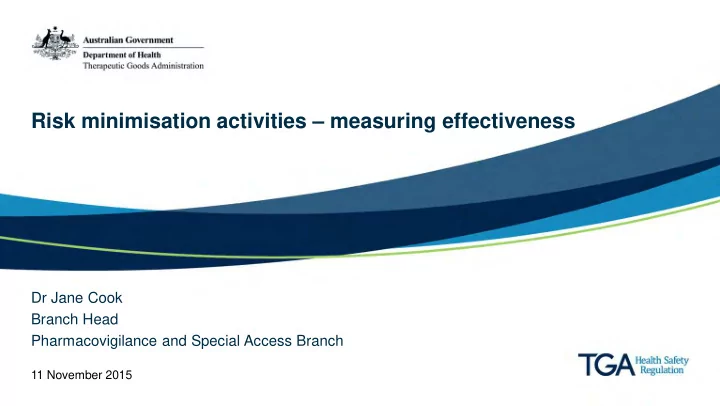

Risk minimisation activities – measuring effectiveness Dr Jane Cook Branch Head Pharmacovigilance and Special Access Branch 11 November 2015
Risk Minimisation Programme • You have identified the risks to be mitigated. • You have selected the tools (activities) to be used in the programme. • You now need to ensure the activities will meet their objectives and be successful in mitigating the identified risks. • You now need to develop an evaluation framework or protocol. 1
Areas to consider when developing a framework • The framework/protocol should be available prior to the start of the program • The framework/protocol should provided in the Risk Management Plan 2
Areas to consider when developing a framework Area Description � Structure Reason for and description of the interventions and tools and their objectives � Design Key aspects, including any comparison, and duration and measures of success � Process Those to address adequacy of the content � indicators Those to assess adequacy of coverage, utilisation and maintenance � Outcome Knowledge and awareness, attitudes, actual behaviours – depend on nature of activity � indicators Those related to patient outcomes such as avoidance of C/ I drugs, morbidity or mortality measures � Analyses How measure of performance will be undertaken against pre-identified measures of success � When will data be collected � What type of analyses will be performed 3
Programme evaluation • Need to measure effectiveness of overall programme as well as each individual component • Indicators selected to evaluate the performance of the programme need to be: – Relevant – Well-defined – Sensitive – Reliable – Evidence-based – Objective – Tailored to the programme 4
Evaluation method • Comprehensive evaluation of overall effectiveness should involve measuring performance in several aspects or domains. • One methodology is the RE-AIM framework: – Reach – Efficacy/effectiveness – Adoption – Implementation – Maintenance 5
Evaluation method: RE-AIM Dimensions Definition Reach Number and representativeness of participants selected for inclusion in evaluation the protocol Efficacy/ effectiveness What are the changes expected – behavioural, patient outcome have these any negative consequences? Adoption Number and representativeness of those that agree to participate – do these continue to be representative – bias? Implementation The degree to which the intervention has been delivered as intended (could also consider cost) M aintenance The extent to which the intervention has been delivered overtime as intended 6
How did the intervention succeed in the “real world” • Implementation fidelity (how closely did the actual program follow the framework/protocol?) • Poor design or poor implementation? • Good outcomes; could they be better? 7
Evaluating implementation fidelity Area Description Examples of assessment methods Exposure Were all aspects delivered to the Survey, review administrative records of delivery of elements to target recipients? participants. Samples need to be representative. Content Was what delivered the same as Focus groups. originally designed? Was the interpretation of the materials as expected? I.e. was messaging “fit for purpose”? Frequency Was it delivered consistently at Stakeholder survey, patient clinical reviews, drug utilisation the frequency in the initial study. activities plan? Duration Was it delivered consistently Sampling as above. throughout the activity period? 8
Evaluating effectiveness of the risk minimisation programme • Outcome measures should be: – Relevant (specific, measurable, time-bound) – Consistent with overall aim of the risk minimisation programme – Meaningful from both clinical and public health perspective 9
Types of suitable outcome measures • Direct vs. indirect outcome indicators – Direct (hard clinical endpoint) – Indirect (surrogate marker) • Single vs. composite outcome indicators – Single – Composite (consists of multiple single endpoints; can reduce sample size) § Example: hepatotoxicity vs. liver failure vs. hepatitis 10
Characteristics of suitable outcome measures Characteristic Description Preventable or mitigatable Specific Clearly defined and requires little judgement Easy to diagnose/ detect Easy to identify and confirm Rich in information Consider periodic rather than one off sampling Responsive Is sensitive the proposed activity Reliable Precise, reproducible, unlikely to be variable on repeated measures Internally validity Linked to use External validity Generalisable to general population Clinical relevance Likely to influence treatment choices Practical Easily implementable and low cost 11
Evaluation designs • Comparator – can be difficult where has been required as part of registration. • Staggered roll out. • Before and after comparison, if available. • Trend analysis through interrupted time series (periodic sampling) and use of other existing databases e.g. health claims data. • Should confirm persistence and maintenance of the programme impact over time. 12
Other considerations • When would evaluation cease? • When could the risk minimisation activity cease? 13
Summary • Life-cycle approach • Evaluation framework as part of development of the activity • Evaluation of the parts and the whole of the risk minimisation programme • Should be simple, pragmatic and user friendly to prevent undue clinician and patient workload • Measures should be clearly defined, easy to use, reproducible and practical • Risk management programme should aim to in the real world ensure that “the right prescriber provides the right medicine to the right patient at the right dose and right time”. 14
Summary From: Practical approaches to risk minimisation for medicinal products: Report of CIOMS Working Group IX. 15 Geneva, Switzerland: Council for International Organizations of Medical Sciences (CIOMS), 2014.
Recommend
More recommend